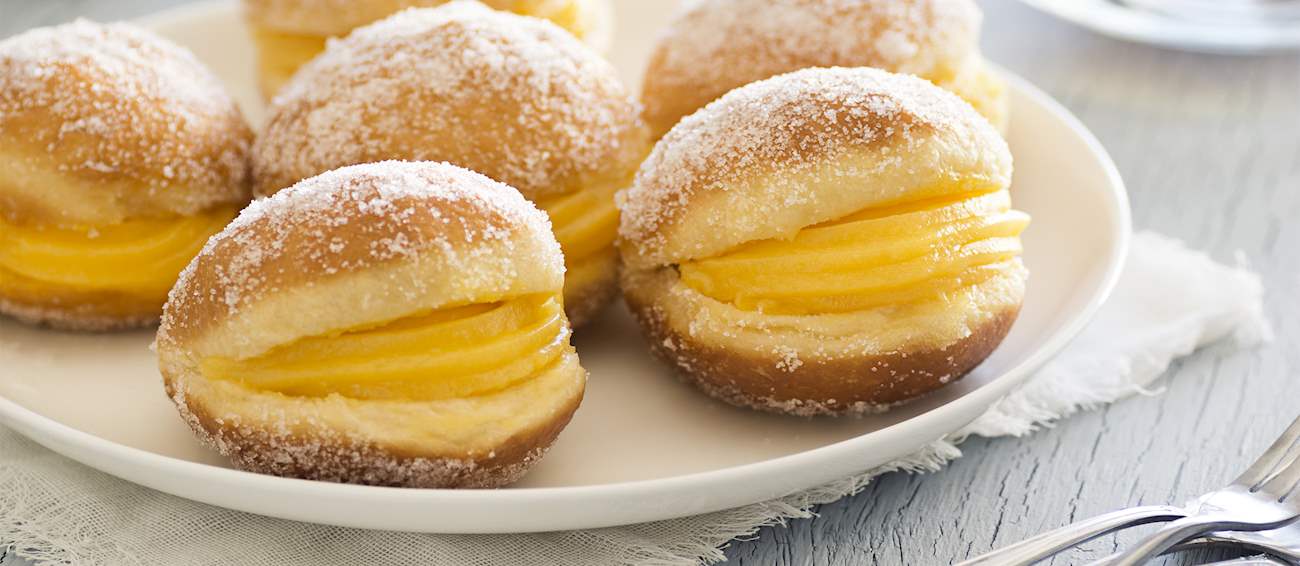Pane e olio is an Italian phrase meaning bread and oil, referring to a simple yet classic Italian dish that highlights the quality of its basic ingredients: bread and olive oil. Traditional Italian bread such as ciabatta, focaccia, or a rustic country loaf is typically used, while extra virgin olive oil (EVOO) is the oil of choice due to its superior flavor and health benefits.
High-quality, cold-pressed olive oil from regions like Tuscany or Puglia is ideal. The bread is usually sliced and may be served fresh or lightly toasted, with toasting enhancing its texture and providing a warm base for the olive oil. The olive oil is typically poured into a small dish or bowl for dipping, though some variations may include a drizzle of olive oil directly on the bread slices.
Bolas de Berlim are Portuguese donuts that are sliced in half, then filled with sweet and creamy egg-based custard. Fluffy on the exterior and thick and creamy on the interior, these donuts are typically rolled in granulated sugar before being filled with the custard.
On the Portuguese coast, vendors sell these tasty balls on numerous beaches, and locals love to consume them while sunbathing. Although bolas de Berlim are typically filled with custard, they can also be ordered sem creme, meaning without the creamy filling.
Pão com chouriço is a traditional snack. It consists of yeasted dough rolls that are filled with the famous pork sausage known as chouriço. The bread rolls are usually made with flour, yeast olive oil, salt, and slices of chouriço sausage.
Once the dough has been prepared, it's typically rolled into rectangles, topped with slices of chouriço, then rolled and closed. These delicious snacks are baked in the oven until golden brown, and it's recommended to serve them while still warm.
Portuguese rissóis are a type of savory pastry similar to empanadas or turnovers. They consist of a dough filled with a variety of fillings, which can include shrimp (rissóis de camarão), minced meat (rissóis de carne), or codfish (rissóis de bacalhau).
The filled dough is then breaded and deep-fried until golden and crispy. Rissóis are a popular snack or appetizer in Portugal, often served at gatherings, parties, and as part of a selection of petiscos (Portuguese tapas).
Characterized by its round, elongated shape, this sweet Portuguese treat combines buttery pastry and a creamy, cinnamon-spiced egg yolk filling. The name of the pastry is linked to campinos - traditional cattle herders who use long wooden sticks (pampilhos) to encourage cattle to move.
Although it is found in other Portuguese regions, pampilho is traditionally associated with Santarém. It is typically enjoyed for breakfast or as a sweet mid-day snack.
Rabanada is the Portuguese and Brazilian version of french toast. It's made with round or oval stale bread cut in thick slices that's dipped in milk (or milk, sugar, and vanilla) and beaten eggs, fried in oil, then sprinkled with cinnamon sugar.
As a result, rabanada is sweeter and crunchier than the American french toast. The first mention of rabanada dates back to the 15th century, when it was described by Juan del Encina as a dish that's helpful for recovery from childbirth, which is why rabanada is alsko known as fatia parida, meaning slices for the new mom.
Pica pau is a traditional dish consisting of small pieces of fried beef in a light gravy made with beer, garlic, oil, chili, and mustard. The dish is usually consumed as a snack, accompanied by a few glasses of cold beer and bread for mopping up the sauce.
When served, pica pau is traditionally topped with olives and pickled carrots and cauliflowers. The name of the dish means woodpecker, because you pick at the beef with a wooden toothpick. Pica pau is a staple of the Portuguese tascas – tiny little restaurants.
This clam-shaped Portuguese delicacy is made with a puff pastry shell that is filled with a unique mixture of minced veal, bread, and onions. The tradition of preparing pastel de Chaves dates back to 1862, and according to a popular legend, the first person to sell these unique pastries was Teresa Feliz Barreira, the founder of Casa do Antigo Pasteleiro, the first establishment where pastel de Chaves could be bought.
The original recipe stayed in her possession for 75 years, until the 1940s, when other bakeries in Chaves started to manufacture and sell the same product. The Portuguese city of Chaves protected this famous pastry as their authentic product, which licensed them to be the only location where pastel de Chaves can be produced and sold.
Milho frito is a traditional specialty made with cooked cornmeal that is cut into small squares and fried in oil. It originated as a frugal dish in the Portuguese region of Madeira, and was initially prepared plain. Today it is usually enriched with thinly sliced cabbage, garlic, and a variety of fresh herbs.
Milho frito can be enjoyed as a nutritious snack but is traditionally served as a complement to other meat or seafood dishes.
MAIN INGREDIENTS
Pataniscas are traditional Portuguese fritters made primarily from salted cod (bacalhau). The dish is characterized by its simple batter, which typically includes flour, eggs, and finely chopped onions and garlic, mixed with flaked cod. The batter is then spooned into hot oil and fried until golden brown and crispy.
Pataniscas are commonly served as appetizers or snacks, often accompanied by a side of rice, salad, or beans. They are a popular choice in Portuguese cuisine for their flavorful and satisfying taste. These fritters are especially connected with the city of Lisbon and the Estremadura province.
TasteAtlas food rankings are based on the ratings of the TasteAtlas audience, with a series of mechanisms that recognize real users and that ignore bot, nationalist or local patriotic ratings, and give additional value to the ratings of users that the system recognizes as knowledgeable. For the “Top 21 Portuguese Snacks” list until March 21, 2025, 1,533 ratings were recorded, of which 1,041 were recognized by the system as legitimate. TasteAtlas Rankings should not be seen as the final global conclusion about food. Their purpose is to promote excellent local foods, instill pride in traditional dishes, and arouse curiosity about dishes you haven’t tried.













